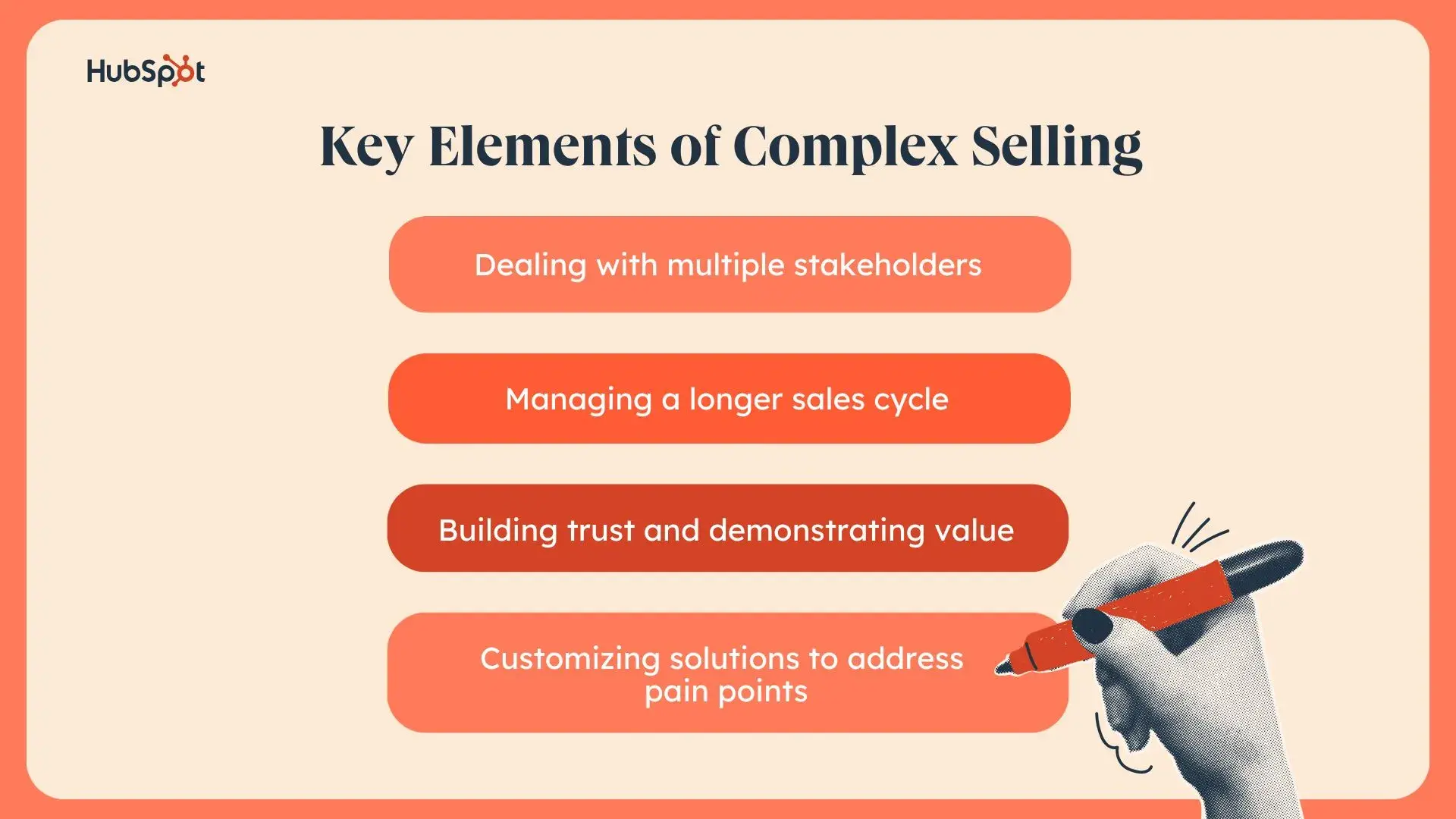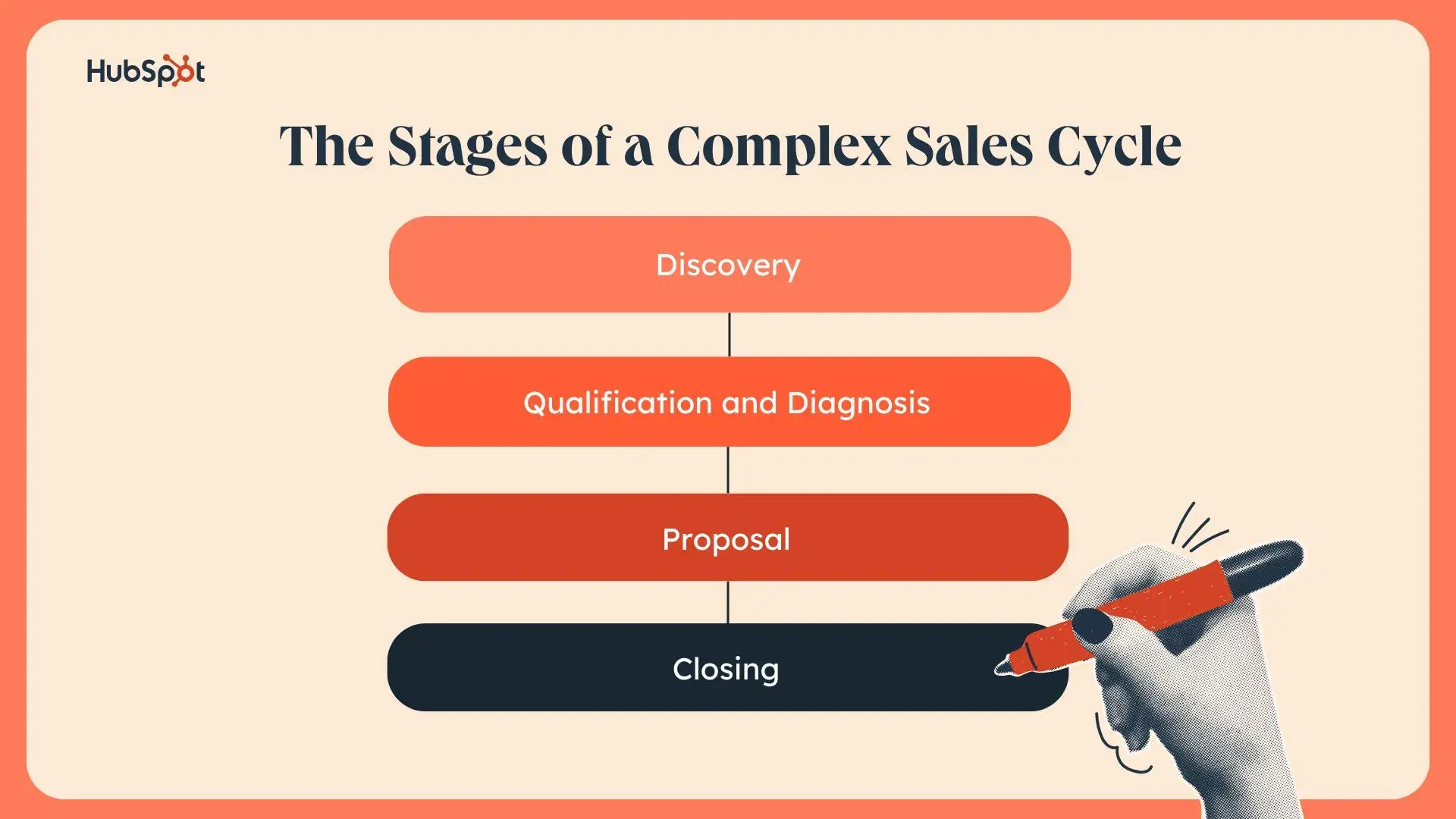With enterprise-level selling, deals take time, patience, and a knack for navigating the labyrinth of stakeholders, pain points, and tailor-made solutions. That’s why these deals, with their extended cycles and multifaceted conversations, earn the title of complex sales. After all, you call ‘em how you see ‘em, right?
In this post, I’ll dive into what makes complex selling so, well, complex — and how you can truly conquer the craft of closing these big-ticket deals without breaking a sweat. Let’s unpack it together.
Table of Contents:
- What is complex selling?
- Key Elements of Complex Selling
- Complex Sales Example
- The Stages of a Complex Sales Cycle
- How to Win at Complex Selling
- My Closing Thoughts on Closing Big Deals
What is complex selling?
Complex sales are most common in B2B sales environments. They can also occur in consumer-focused settings, like deals made when purchasing a house, but this is less common.
What is complex selling?
Complex sales are most common in B2B sales environments. They can also occur in consumer-focused settings, like deals made when purchasing a house, but this is less common.
Overall, a complex sale is marked by three key elements:
- Higher perceived risk resulting from higher price points
- A longer sales cycle (6+ months)
- Multiple stakeholders
Complex selling is so unique — and challenging — that it’s less about “pitching” your product/service. Instead, complex selling is all about positioning yourself as a credible advisor.
If you’re dealing with a complex sale, be prepared to do a little more work and — depending on how you feel about going the extra mile — for your role to extend far beyond the title of “sales rep.” Annnnd if that sentence just made you immediately stop reading — which I totally understand — check out a few statistics from this article I recently wrote (ft. data from HubSpot’s 2024 State of Sales Report):
- On average, sales reps report that there are five decision-makers involved in the sales process
- 82% of sales pros say building relationships + connecting with people is the most important part of selling
- The top three B2B sales strategies for 2024 included setting up a face-to-face meeting, understanding the key business challenges prospects face, and establishing rapport with customers during the sales process
- 66% of sales professionals say AI can help them provide a more personalized experience and understand their customers better
Clearly, the insights don’t lie. Just as I mentioned above, complex selling isn’t surface-level. It’s all about building trust, navigating relationships, and, most importantly, delivering real value to your customers.
If you’re still looking for clarity on what’s involved in complex selling, have no fear. In the next section, I’ll break down its foundational components, hopefully giving you a clearer understanding of the intricacies behind these high-stakes deals.
Key Elements of Complex Selling

1. Dealing with multiple stakeholders.
Unlike transactional sales, closing a complex deal means convincing multiple stakeholders. The number of stakeholders and their positions in the company can vary depending on the industry.
For example, suppose you’re selling technical software to a business. The final decision-maker may be the company’s Chief Engineering Officer, but that could quickly change to the People Operations Executive if you’re selling a productivity service.
However, in this example, the chief executive is the last person you’ll have to convince, and a series of people below the C-suite will likely be involved in the process. Gone are the days of persuading one person to buy your product. With complex selling, it might be five, potentially 10. It’s also possible that you may never meet all the people involved in the buying process.
Another great thing about complex selling? It’s full of surprises.
2. Managing a longer sales cycle.
If you’re handling a complex sale, be prepared for some commitment; if you’re wondering why this is, here’s your answer: A complex sales process is way longer than a transactional sale; it may last anywhere from six to 24 months.
Without going into too much detail, a longer sales cycle allows all engaged parties to take the time to understand the product and its benefits. While a longer sales cycle may sound daunting, when you’re working with B2B deals, you learn to be grateful for the extra time.
3. Building trust and demonstrating value.
Trust is the only currency in a complex sale that’ll keep the deal moving forward.
Complex sales aren’t won with flashy presentations or buzzwords. They’re built on good ol’ trust and reliability. This means proving to your prospects that you’re not just trying to sell them something. Instead, you’ve got to show them that you’re genuinely invested in solving their problems. This may mean more rapport building on the front end, but when it comes time to close the deal, you’ll be happy you did the brunt of the work in the first place.
4. Customizing solutions to address pain points.
If you have a textbook with cookie-cutter methodologies on how to approach a complex sale, throw it away. Right now. Complex selling calls for personalization at every part of the process, including the proposal stage, which means you’ve got to put some elbow grease into ideating solutions for your clients. You’ll need to dig deep into your discovery phase findings and tailor your pitch to speak directly to their pain points.
This isn’t just about tweaking a PowerPoint; it’s about showing them you “get it” and offering a solution that aligns perfectly with their unique needs. In short, customization isn’t just a nice touch — it’s the difference between a “maybe” and a signed contract.
Complex Sales Example
While complex sales typically fall under the B2B umbrella, no two deals look alike. The diversity of industries and challenges within the B2B space means every deal has its own set of puzzles to solve, players to please, and priorities to juggle.
For example, let’s talk commercial insurance sales. They fall under the category of a complex sale because they require insurance salesfolks to really know their client inside and out, including key areas such as:
- Business operations
- Workforce needs
- Growth plans
- Industry-specific risks and regulations
- Financial constraints and budget considerations
Additionally, as their client’s business grows or pivots, its insurance needs may change, introducing another layer of nuance. As a result, insurance sales pros must be proactive and ready to share individualized policies that align with their client’s current and future needs.
And in addition to all these factors, commercial insurance sales often involve negotiations with various collaborators, from HR teams to CFOs, which makes the sales cycle extra lengthy.
This intricate balancing act, full of moving parts, is what defines a complex sale. In the end, success in commercial insurance — or any complex sale — requires a mix of deep expertise, adaptability, and the ability to navigate relationships with finesse.
The Stages of a Complex Sales Cycle

Despite their differences, the complex sales cycle mirrors typical sales cycle stages. The cycle includes four stages:
- Discovery
- Qualification and Diagnosis
- Proposal
- Closing
1. The Discovery Stage
During this phase, you’ll likely spend your time familiarizing yourself with the business you’re selling to.
At this point in the complex selling process, consulting with the business you’re working with will provide you with a baseline understanding of their pain points and expectations (so you can get a clear picture of how your tool can address those problems).
You should know something else about this stage: It’s quite a research project. You’ll use this stage to find out everything you can about the stakeholders and their relationships to the service you’re selling. Expect this stage to be where you’ll figure out stuff like:
- Your client’s timeline (when they want/need a solution for this business, and what’s driving this timeline)
- Potential objections (any concerns or hesitations that they have about your product/service and/or the sales process)
- Key performance metrics (also known as KPIs, aka how your client’s business will measure the success of your product/service)
Gathering as much detailed information as possible from your client during this stage will make it easier for you to be successful as you move through the complex sales process and, eventually, close the deal.
2. The Qualification and Diagnosis Stage
During this stage of complex selling, you’ll use the information gathered during the discovery stage to diagnose your prospect’s issues. Understanding your client’s pain points and how your product can solve them will pay off significantly and clarify why your solution is the best option.
If you convince your prospect that not addressing the diagnosis will negatively affect their future growth, they’ll be more likely (and, hopefully, eager) to engage with your solutions. Remember: At this point in the game, it’s all about presentation, my dear reader.
3. The Proposal Stage
If you’ve reached this point of a complex sale, anticipate using your diagnosis to present stakeholders with detailed examples of how your solution directly addresses and solves their pain points. To do this well, you may want to include things like:
- Testimonials or case studies from other businesses you’ve successfully helped
- A customized implementation plan that outlines resources and next steps
- Visuals or demonstrations (i.e., product demos, mockups, etc.) that bring your solution to life
At this point in the complex selling process, you want to a) be ultra-confident in your solutions and b) ensure that any involved stakeholders are assured of your understanding of their situation.
Since these deals include multiple layered solutions, providing them with a detailed plan accompanied by tons of other materials will give them a well-rounded view of your offer.
4. The Closing Stage
After you’ve done the work to convince all stakeholders of the benefits of your service, you’ll do what you’ve been waiting for: Closing the deal.
The final contract, which addresses significantly more solutions, differentiates a complex sales closing stage from transactional sales. A regular contract may outline one or two solutions, but your complex deal may address ten.
Maintaining contact with the client and presenting yourself as a resource after the deal is finalized shows them you’re eager to help them should any issues arise. If this deal is part of a contract, maintaining a relationship can ensure the contract is renewed.
How to Win at Complex Selling
While the sales cycle for complex selling may be pretty straightforward, there’s still much to uncover about what it takes to excel at it. I recently sat down with Trav Simat, a leading Enterprise Business Development Representative (BDR) at HubSpot, to discuss:
- Understanding the complex sales process
- How he’s navigated its roadblocks
- Strategies he’s used to manage/mitigate risk, misalignment, and all the little things that come with the territory of a complex sale
Here’s what he had to share regarding how to improve your complex selling skills (and ditch any outdated sales tactics that simply aren’t working anymore):
1. Want to win a complex sale? Become a product expert first.
When I asked Trav about any specific strategies he swore by when navigating a tricky enterprise-level deal, he told me something I wasn’t quite expecting to hear. I think you’ll be surprised, too.
“With complex sales, you have to be a product expert in order to provide the correct guidance,” Trav told me. He then continued, “There’s no doubt about it. You’ve also got to have a deep understanding of what the customer’s current challenges are, could be, and how your tailored solution is going to be able to drive results or make their business more efficient.”
Evidently, Trav’s advice is a reminder that in complex selling, knowledge is your greatest asset. Whether it be about the product you’re selling, the person you’re talking to, or the business you’re working with, the more you know, the more likely you are to go farther in your deal.
2. Understand your Ideal Customer Profile (ICP).
When it comes to finding the right fit for a complex sales deal, Trav goes back to the basics: identifying his target market, also known as an ICP.
“You need to understand your ICP and what businesses can actually benefit from your solution before any discovery even takes place,” Trav admitted. “From there, you have to slowly build relationships and try and go as wide as you can to have as many meaningful conversations with as many prospects as possible that have decision-making power at the company you’re trying to work with.”
Like Trav emphasized, complex sales aren’t just about finding any deal — they’re about finding the right deal. By honing in on your ideal customer profile and focusing on meaningful, relationship-driven conversations with key decision-makers, you’re not just selling a solution — you’re building partnerships that last.
Pro Tip: You can use HubSpot’s Sales Plan Template to outline your target market, amongst other things (like your prospecting strategy and overall sales goals), to make B2B selling effortless and stress-free.
3. Like the Kenny Rogers song says: Know when to hold ‘em, know when to fold ‘em, and know when to walk away.
When it comes to securing a complex sale success, Trav says that you’ve got to occasionally abandon ship, especially when the prospect doesn’t seem worth your time.
“I’ve also noticed over the years that the best salespeople can qualify and disqualify their products as quickly as possible in order not to waste anyone’s time,” Trav explained. “A lot of people make forced deals that aren’t there when they really should do a better job at disqualifying the deal and moving onto better opportunities that actually have a chance at closing. That’s what truly separates the champions from the rest.”
Knowing when to walk away is just as important as knowing when to push forward. The best salespeople don’t chase every lead. Instead, they prioritize their time and energy on opportunities that have real potential.
My Closing Thoughts on Closing Big Deals
Alright. We’ve reached the end of the road. If you walk away from this post having learned anything from this post, I hope it’s the following:
- Success in complex sales comes down to mastering the basics (ex: building trust, addressing pain points with custom solutions) and implementing your spin on them
- Complex sales require attention to detail at every step of the buyer’s journey
- Devote your energy and time to worthwhile prospects; don’t be afraid to ditch the ones that don’t
Complex sales aren’t about landing the deal but delivering real, measurable value. When you approach each stage with care and intention, you set yourself up to close confidently.
So, take a deep breath, double-check your pitch, and dive in. You’ve got this, my dear reader. After all, big deals don’t just build themselves, and you’re the person who knows exactly how to make them happen.
Editor's note: This post was originally published in September 2020 and has been updated for comprehensiveness.
Sales Methodology

.webp)




![I Learned How Sales Champions Drive Deals Forward — Here’s What You Should Know [+ Recent Data]](https://53.fs1.hubspotusercontent-na1.net/hubfs/53/sales-champion-1-20250110-9355712-1.webp)
![Decoding Buying Signals in Sales [+ Examples & What I Learned]](https://53.fs1.hubspotusercontent-na1.net/hubfs/53/buying-signals-1-20250501-3647992.webp)



-3.webp)
